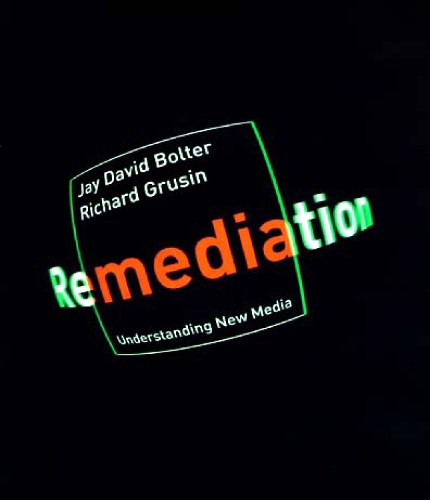
Remediation: Understanding New Media
(Paperback)
Publishing Details
Remediation: Understanding New Media
By (Author) Jay David Bolter
By (author) Richard Grusin
MIT Press Ltd
MIT Press
6th January 2000
6th January 2000
United States
Classifications
Tertiary Education
Non Fiction
302.234
Physical Properties
Paperback
312
Width 178mm, Height 229mm, Spine 13mm
522g
Description
Media critics remain captivated by the modernist myth of the new: they assume that digital technologies such as the World Wide Web, virtual reality, and computer graphics must divorce themselves from earlier media for a new set of aesthetic and cultural principles. This text offers a theory of mediation for our digital age that challenges this assumption. They argue that visual media achieve their cultural significance precisely by paying homage to, rivaling, and refashioning such earlier media as perspective painting, photography, film and television. They call this process of refashioning "remediation" and they note that earlier media have also refashioned one another: photography remidiated painting, film remediated stage production and photography, and television remediated film, vaudeville and radio. In chapters devoted to individual media or genres (such as computer games, digital photography, virtual reality, film, and television), the authors illustrate the process of remediation and its two principal styles or strategies: transparent immediacy and hypermediacy. Each of these strategies has a long and complicated history. A painting by the 17th-century artists Pieter Saenredam, a photograph by Edward Weston, and a computer system for virtual reality are all attempts to achieve transparent immediacy by ignoring or denying the presence of the medium. A medieval illuminated manuscript, an early 20th-century photomontage, and today's buttoned and windowed multimedia applications are instances of hypermediacy - a fascination with the medium itself. Although these two strategies appear contradictory, they are in fact the two necessary halves of remediation.
Reviews
The authors do a splendid job of showing precisely how technologies like computer games, digital photography, film television, the Web, and virtual reality all turn on the mutually constructive strategies of generating immediacy and making users hyperaware of the media themselves...The authors lay out a provocative theory of contemporary selfhood, one that draws on and modifies current notions of the 'virtual' and 'networked' human subject. Clearly written and not overly technical, this book will interest general readers, students, and scholars engaged with current trends in technology.
ChoiceAuthor Bio
Jay David Bolter is Wesley Chair of New Media and Codirector of the Augmented Media Lab at Georgia Institute of Technology. He is the author of Remediation- Understanding New Media (with Richard Grusin), Windows and Mirrors- Interaction Design, Digital Art and the Myth of Transparency (with Diane Gromala), both published by the MIT Press, and other books. Richard Grusin is Professor and Chair of English at Wayne State University in Detroit.
